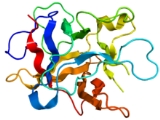
Kunitz STI protease inhibitor
Encyclopedia
Kunitz STI protease inhibitor is a type of protein
contained in legume seeds which functions as a protease inhibitor
. Kunitz-type Soybean Trypsin Inhibitors (STI) are usually specific for either trypsin
or chymotrypsin
. They are thought to protect seeds against consumption by animal predators.
residues and one or two intra-chain disulfide bond
s. The best conserved region is found in their N-terminal section. The crystal structures of soybean trypsin inhibitor (STI), trypsin inhibitor DE-3 from the Kaffir tree Erythrina caffra
(ETI) and the bifunctional proteinase K/alpha-amylase inhibitor from wheat (PK13) have been solved, showing them to share the same 12-stranded beta sheet
structure as those of interleukin 1 and heparin-binding growth factor
s. The beta-sheets are arranged in 3 similar lobes around a central axis, 6 strands forming an anti-parallel beta barrel
. Despite the structural similarity, STI shows no interleukin-1 bioactivity, presumably as a result of their primary sequence disparities. The active inhibitory site containing the scissile bond is located in the loop between beta-strands 4 and 5 in STI and ETI.
The STIs belong to a superfamily that also contains the interleukin-1 proteins, heparin binding growth factors (HBGF
) and histactophilin, all of which have very similar structures, but share no sequence similarity with the STI family.
Protein
Proteins are biochemical compounds consisting of one or more polypeptides typically folded into a globular or fibrous form, facilitating a biological function. A polypeptide is a single linear polymer chain of amino acids bonded together by peptide bonds between the carboxyl and amino groups of...
contained in legume seeds which functions as a protease inhibitor
Protease inhibitor (biology)
In biology and biochemistry, protease inhibitors are molecules that inhibit the function of proteases. Many naturally occurring protease inhibitors are proteins....
. Kunitz-type Soybean Trypsin Inhibitors (STI) are usually specific for either trypsin
Trypsin
Trypsin is a serine protease found in the digestive system of many vertebrates, where it hydrolyses proteins. Trypsin is produced in the pancreas as the inactive proenzyme trypsinogen. Trypsin cleaves peptide chains mainly at the carboxyl side of the amino acids lysine or arginine, except when...
or chymotrypsin
Chymotrypsin
Chymotrypsin is a digestive enzyme that can perform proteolysis. Chymotrypsin preferentially cleaves peptide amide bonds where the carboxyl side of the amide bond is a tyrosine, tryptophan, or phenylalanine. These amino acids contain an aromatic ring in their sidechain that fits into a...
. They are thought to protect seeds against consumption by animal predators.
Structure
Proteins from the Kunitz family contain from 170 to 200 amino acidAmino acid
Amino acids are molecules containing an amine group, a carboxylic acid group and a side-chain that varies between different amino acids. The key elements of an amino acid are carbon, hydrogen, oxygen, and nitrogen...
residues and one or two intra-chain disulfide bond
Disulfide bond
In chemistry, a disulfide bond is a covalent bond, usually derived by the coupling of two thiol groups. The linkage is also called an SS-bond or disulfide bridge. The overall connectivity is therefore R-S-S-R. The terminology is widely used in biochemistry...
s. The best conserved region is found in their N-terminal section. The crystal structures of soybean trypsin inhibitor (STI), trypsin inhibitor DE-3 from the Kaffir tree Erythrina caffra
Erythrina caffra
Erythrina caffra, the Coast Coral Tree, is a tree native to southeastern Africa, which is often cultivated and has introduced populations in India. It is the official tree of Los Angeles, California in the United States....
(ETI) and the bifunctional proteinase K/alpha-amylase inhibitor from wheat (PK13) have been solved, showing them to share the same 12-stranded beta sheet
Beta sheet
The β sheet is the second form of regular secondary structure in proteins, only somewhat less common than the alpha helix. Beta sheets consist of beta strands connected laterally by at least two or three backbone hydrogen bonds, forming a generally twisted, pleated sheet...
structure as those of interleukin 1 and heparin-binding growth factor
Heparin-binding EGF-like growth factor
Heparin-binding EGF-like growth factor is a member of the EGF family of proteins. It has been shown to play a role in wound healing, cardiac hypertrophy and heart development and function.-Interactions:...
s. The beta-sheets are arranged in 3 similar lobes around a central axis, 6 strands forming an anti-parallel beta barrel
Beta barrel
A beta barrel is a large beta-sheet that twists and coils to form a closed structure in which the first strand is hydrogen bonded to the last.Beta-strands in beta-barrels are typically arranged in an antiparallel fashion...
. Despite the structural similarity, STI shows no interleukin-1 bioactivity, presumably as a result of their primary sequence disparities. The active inhibitory site containing the scissile bond is located in the loop between beta-strands 4 and 5 in STI and ETI.
The STIs belong to a superfamily that also contains the interleukin-1 proteins, heparin binding growth factors (HBGF
Heparin-binding EGF-like growth factor
Heparin-binding EGF-like growth factor is a member of the EGF family of proteins. It has been shown to play a role in wound healing, cardiac hypertrophy and heart development and function.-Interactions:...
) and histactophilin, all of which have very similar structures, but share no sequence similarity with the STI family.

